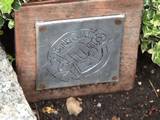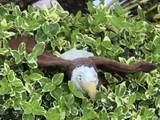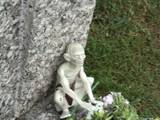OSTADAN'S LORE & LETTERS:
A Visit to Wolvercote
Note
The photographs in this article are larger than they appear on this page. You can see them in full resolution by clicking on the image. The two QuickTime movies linked into this article are each about 8 megabytes in length. If you are not on a fast network connection, considerable patience may be required.
This year, I took my vacation in England, primarily to attend the Cambridge Folk Music Festival. But, of course, no fan of the Inklings can possibly book a trip to England without adding a little Oxford tourism into the itinerary, and I am no exception. Rather than giving a detailed Tolkien Geek Travelogue of Oxford, I will describe my visit to one particularly memorable site: Wolvercote Cemetery, site of the grave of Edith Tolkien (1889-1971) and J.R.R. Tolkien (1892-1973).
First, a bit of tourist information. Oddly, none of the Web sites I examined before leaving gave directions to the Cemetery; everyone seems to take a taxi. So here are the directions, for the record. From central Oxford, it is possible to walk all the way to Wolvercote. Fortify yourself with a good lunch at the Eagle and Child pub (you were planning on visiting there anyway, right?) because the walk will probably take about an hour and a half or more. You simply continue up St. Giles from the Eagle and Child, taking the left fork (Woodstock). After quite a long walk through an increasingly suburban area, you reach a roundabout. Proceed carefully around it anti-clockwise, crossing the A40 (North Way) and go out on Five Mile Drive, about 90 degrees around from Woodstock. It's about half a mile or so east along Five Mile Drive, through a rather new-looking suburban neighborhood, to Wolvercote Cemetery, which is on the north side of the road. When I attempted to walk all the way, I had to turn back because a large thunderstorm drifted in during that time. A more practical approach is simply to take the #6 bus up Woodstock until it turns just a little way before the roundabout, then walk back to Woodstock and complete the walk on foot, perhaps 15 minutes or so of walking. In the center of the Cemetery is a building with a map. The Tolkien grave site is notably the only grave marked on this map, in the left-hand portion; it is, of course, in the Catholic section.
My own visit was on a balmy and overcast morning; really quite pleasant. I was practically the only person present as far as I could tell. The path to the grave site is very well marked; again, this appears to be a unique distinction for Tolkien's grave. In a way, I was not quite sure why I was going. As a tourist, I am generally not someone who finds much interest in the graves or tombs of famous people. I do not imagine the shades of famous people hanging around watching to see who shows up; and one grave pretty much looks like another. I must confess, in fact, that I came partly out of a sense of obligation (what self-respecting Tolkien fan would not visit this site?) and partly because I hoped to photograph the site in a way that has not, to my knowledge, been done before, so as to allow TORN readers to see the site in a new and interesting way. But as it turned out, I was far more moved by my visit than I anticipated.

The grave itself is, of course, unique. It is very likely that the reader already knows the inscriptions that Tolkien devised, naming Edith as "LUTHIEN" and himself as "BEREN". As he wrote to Christopher Tolkien,
She was (and knew she was) my Lúthien … she was the source of the story that in time became the chief part of the Silmarillion. It was first conceived in a small woodland glade filled with hemlocks at Roos in Yorkshire ... In those days her hair was raven, her skin clear, her eyes brighter than you have seen them, and she could sing -- and dance. (Letters #340, 11 and 13 July 1972)
  
The next obvious distinction of the Tolkien grave is that it is covered with well-tended growth: roses and other plant life are abundant. It is somehow satisfying to see the grave of someone whose work celebrated (among other things) the simple joy of a garden become a small garden itself. But the thing that was the most striking was the collection of objects that others had left on the grave. A plaque from the "Bard's Guild"; an eagle; small notes held down by rocks; even a little sculpted figure of Gollum! And most moving of all were the notes that had been left recently, pinned to the rose bush, thanking Tolkien for the inspiration and joy he had brought to the anonymous writers' lives.
It is said that funerals are not for the departed, but for those who remain behind. The same may be said of Tolkien's grave. It was planned, of course, simply as a family plot, not a public memorial. But the legions of Tolkien's fans, trickling steadily into Wolvercote Cemetary over the last three decades, have transformed it into something unique: a place in which fans can express (in a myriad of ways) their appreciation for the man whose work has pierced their hearts. It seemed to me the very distillation of what being a "Tolkien fan" represents.
 
With an odd feeling of joyful solemnity, I set up my tripod and carried out my planned "mission": I took a series of photographs in a full circle showing the environment around the grave. These I have stitched together into a QuickTime VR panorama. As far as I know, while many pictures of the grave and headstone have appeared on the Net and in books over the years, nobody has taken a panoramic picture that gives a sense of what the surroundings are like. And so, [here] is one part of Wolvercote Cemetary, as it appeared on one quiet and misty August morning.
I packed my cameras and tripod and took one last look at the grave. It was time to go. I walked about ten feet, and found I could not help myself: feeling a bit foolish, I looked back and said quietly, "Thanks for everything, Professor."
-- Ostadan
|
![[ Green Books ]](http://img-greenbooks.theonering.net/images/gb_logo.gif)
![[ Green Books - Exploring the Words and Worlds of J.R.R. Tolkien ]](http://img-greenbooks.theonering.net/images/gb_topnav.gif)





